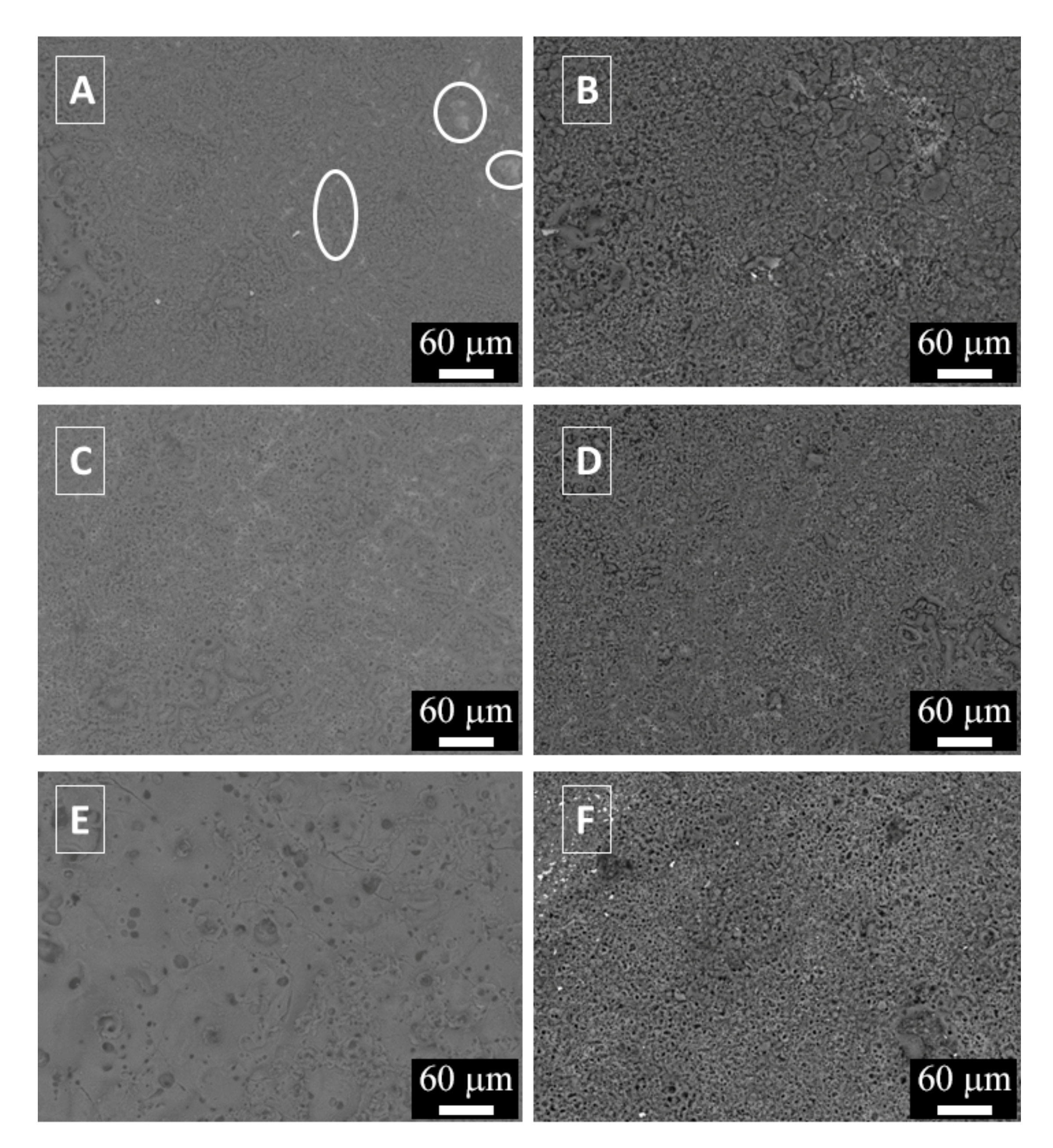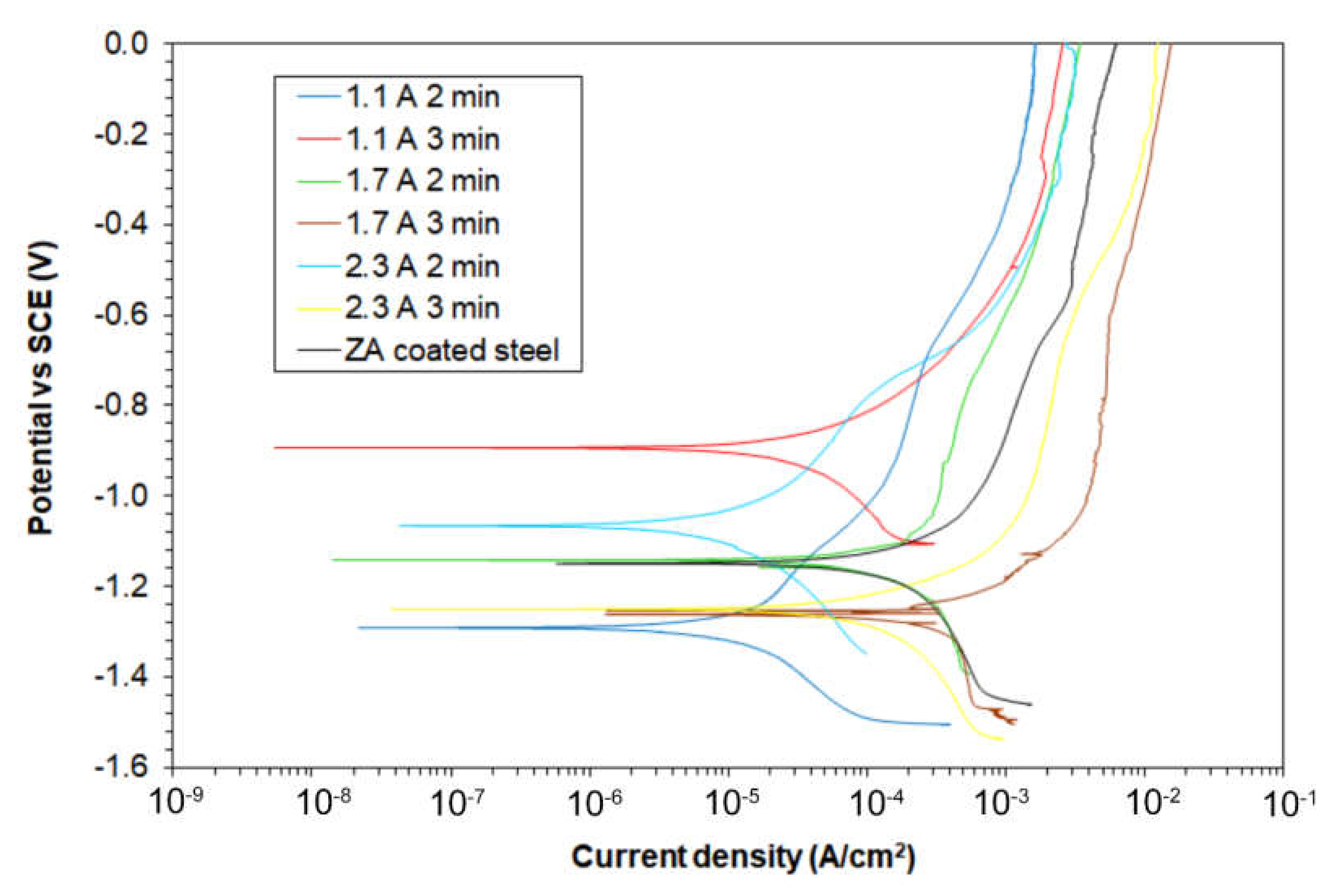Microstructural and Corrosion Properties of PEO Coated Zinc-Aluminized (ZA) Steel
Abstract
:1. Introduction
2. Materials and Methods
3. Results and Discussion
3.1. Microstructural Characterization
3.2. Corrosion Resistance
4. Conclusions
Author Contributions
Funding
Conflicts of Interest
References
- Martin, J.; Melhem, A.; Shchedrina, I.; Duchanoy, T.; Nominé, A.; Henrion, G.; Czerwiec, T.; Belmonte, T. Effects of electrical parameters on plasma electrolytic oxidation of aluminium. Surf. Coat. Technol. 2013, 221, 70–76. [Google Scholar] [CrossRef]
- Curran, J.A.; Clyne, T.W. Porosity in plasma electrolytic oxide coatings. Acta Mater. 2006, 54, 1985–1993. [Google Scholar] [CrossRef]
- Pezzato, L.; Coelho, L.B.; Bertolini, R.; Settimi, A.G.; Brunelli, K.; Olivier, M.; Dabalà, M. Corrosion and mechanical properties of plasma electrolytic oxidation-coated AZ80 magnesium alloy. Mater. Corros. 2019, 70, 2103–2112. [Google Scholar] [CrossRef]
- Fattah-Alhosseini, A.; Keshavarz, M.K.; Molaei, M.; Gashti, S.O. Plasma Electrolytic Oxidation (PEO) Process on Commercially Pure Ti Surface: Effects of Electrolyte on the Microstructure and Corrosion Behavior of Coatings. Met. Mater. Trans. A 2018, 49, 4966–4979. [Google Scholar] [CrossRef]
- Sowa, M.; Simka, W. Effect of DC Plasma Electrolytic Oxidation on Surface Characteristics and Corrosion Resistance of Zirconium. Materials 2018, 11, 723. [Google Scholar] [CrossRef] [Green Version]
- Sowa, M.; Kazek-Kęsik, A.; Krząkała, A.; Socha, R.; Dercz, G.; Michalska, J.; Simka, W. Modification of niobium surfaces using plasma electrolytic oxidation in silicate solutions. J. Solid State Electrochem. 2018, 18, 3129–3142. [Google Scholar] [CrossRef] [Green Version]
- Sowa, M.; Simka, W. Electrochemical Impedance and Polarization Corrosion Studies of Tantalum Surface Modified by DC Plasma Electrolytic Oxidation. Materials 2018, 11, 545. [Google Scholar] [CrossRef] [Green Version]
- Mingo, B.; Arrabal, R.; Mohedano, M.; Llamazares, Y.; Matykina, E.; Yerokhin, A.; Pardo, A. Influence of sealing post-treatments on the corrosion resistance of PEO coated AZ91 magnesium alloy. Appl. Surf. Sci. 2018, 433, 653–667. [Google Scholar] [CrossRef]
- Pezzato, L.; Rigon, M.; Martucci, A.; Brunelli, K.; Dabalà, M. Plasma Electrolytic Oxidation (PEO) as pre-treatment for sol-gel coating on aluminum and magnesium alloys. Surf. Coatings Technol. 2019, 366, 114–123. [Google Scholar] [CrossRef]
- Pezzato, L.; Cerchier, P.; Brunelli, K.; Bartolozzi, A.; Bertani, R.; Dabalà, M. Plasma electrolytic oxidation coatings with fungicidal properties. Surf. Eng. 2019, 35, 325–333. [Google Scholar] [CrossRef]
- Saikiran, A.; Hariprasad, S.; Arun, S.; Rama Krishna, L.; Rameshbabu, N. Effect of electrolyte composition on morphology and corrosion resistance of plasma electrolytic oxidation coatings on aluminized steel. Surf. Coatings Technol. 2019, 372, 239–251. [Google Scholar]
- Wang, Y.; Jiang, Z.; Yao, Z.; Tang, H. Microstructure and corrosion resistance of ceramic coating on carbon steel prepared by plasma electrolytic oxidation. Surf. Coatings Technol. 2010, 204, 1685–1688. [Google Scholar] [CrossRef]
- Wang, Y.; Jiang, Z.; Yao, Z. Preparation and properties of ceramic coating on Q235 carbon steel by plasma electrolytic oxidation. Curr. Appl. Phys. 2009, 9, 1067–1071. [Google Scholar] [CrossRef]
- Wang, Y.; Jiang, Z.; Yao, Z. Microstructure, bonding strength and thermal shock resistance of ceramic coatings on steels prepared by plasma electrolytic oxidation. Appl. Surf. Sci. 2009, 253, 650–656. [Google Scholar] [CrossRef]
- Pezzato, L.; Brunelli, K.; Dolcet, P.; Dabalà, M. Plasma electrolytic oxidation coating produced on 39NiCrMo3 steel. Surf. Coatings Technol. 2016, 307, 73–80. [Google Scholar] [CrossRef]
- Wu, Z.; Xia, Y.; Li, G.; Xu, F. Structure and mechanical properties of ceramic coatings fabricated by plasma electrolytic oxidation on aluminized steel. Appl. Surf. Sci. 2007, 253, 8398–8403. [Google Scholar] [CrossRef]
- Karpushenkov, S.A.; Shchukin, G.L.; Belanovich, A.L.; Savenko, V.P.; Kulak, A.I. Plasma electrolytic ceramic-like aluminum oxide coatings on iron. J. Appl. Electrochem. 2010, 40, 365–374. [Google Scholar] [CrossRef]
- Gu, W.C.; Lv, G.H.; Chen, H.; Chen, G.L.; Feng, W.R.; Zhang, G.L.; Yang, S.Z. Preparation of ceramic coatings on inner surface of steel tubes using a combined technique of hot-dipping and plasma electrolytic oxidation. J. Alloys Compd. 2007, 430, 308–312. [Google Scholar] [CrossRef]
- Stojadinović, S.; Tadić, N.; Vasilić, R. Formation and characterization of ZnO films on zinc substrate by plasma electrolytic oxidation. Surf. Coatings Technol. 2016, 307, 650–657. [Google Scholar] [CrossRef]
- Rocca, E.; Veys-Renaux, D.; Guessoum, K. Electrochemical behavior of zinc in KOH media at high voltage: Micro-arc oxidation of zinc. J. Electroanal. Chem. 2015, 754, 125–132. [Google Scholar] [CrossRef]
- Bian, G.; Wang, L.; Wu, J.; Zheng, J.; Sun, H.; DaCosta, H. Effects of electrolytes on the growth behavior, microstructure and tribological properties of plasma electrolytic oxidation coatings on a ZA27 alloy. Surf. Coatings Technol. 2015, 277, 251–257. [Google Scholar] [CrossRef]
- Li, G.; Mao, Y.; Li, Z.; Wang, L.; DaCosta, H. Tribological and Corrosion Properties of Coatings Produced by Plasma Electrolytic Oxidation on the ZA27 Alloy. J. Mater. Eng. Perform. 2018, 27, 2298–2305. [Google Scholar] [CrossRef]
- Cerchier, P.; Pezzato, L.; Gennari, C.; Moschin, E.; Moro, I.; Dabalà, M. PEO coating containing copper: A promising anticorrosive and antifouling coating for seawater application of AA 7075. Surf. Coat. Technol. 2020, 393, 125774. [Google Scholar] [CrossRef]
- Saha, J.K. Corrosion of Constructional Steels in Marine and Industrial Environment; Springer: New Delhi, India, 2013; pp. 129–143. ISBN 978-81-322-0720-7. [Google Scholar]
- Clyne, T.W.; Troughton, S.C. A review of recent work on discharge characteristics during plasma electrolytic oxidation of various metals. Int. Mater. Rev. 2019, 64, 127–162. [Google Scholar] [CrossRef] [Green Version]
- Blawert, C.; Bala Srinivasan, P. Plasma Electrolytic Oxidation Treatment of Magnesium Alloys. In Surface Engineering of Light Alloys; Dong, H., Ed.; Woodhead Publishing Limited: Cambridge, UK, 2010. [Google Scholar]
- Guan, Y.; Xia, Y. Amorphus coatings deposited on aluminum alloy by plasma electrolytic oxidation. Trans. Nonferrous Met. Soc. China 2005, 15, 565–570. [Google Scholar]
- Troughton, S.C.; Nominé, A.; Dean, J.; Clyne, T.W. Effect of individual discharge cascades on the microstructure of plasma electrolytic oxidation coatings. Appl. Surf. Sci. 2016, 389, 260–269. [Google Scholar] [CrossRef]
- Erfanifar, E.; Aliofkhazraei, M.; Nabavi, H.F.; Sharifi, H.; Rouhaghdam, A.S. Growth kinetics and morphology of plasma electrolytic oxidation coating on aluminum. Mater. Chem. Phys. 2017, 185, 162–175. [Google Scholar] [CrossRef]
- Hussein, R.O.; Nie, X.; Northwood, D.O. An investigation of ceramic coating growth mechanisms in plasma electrolytic oxidation (PEO) processing. Electrochim. Acta 2013, 112, 111–119. [Google Scholar] [CrossRef]
- Al Bosta, M.M.S.; Ma, K.-J.; Chien, H.-H. The effect of MAO processing time on surface properties and low temperature infrared emissivity of ceramic coating on aluminium 6061 alloy. Infrared Phys. Technol. 2013, 60, 323–334. [Google Scholar] [CrossRef]
- Wu, H.L.; Cheng, Y.L.; Li, L.L.; Chen, Z.H.; Wang, H.M.; Zhang, Z. The anodization of ZK60 magnesium alloy in alkaline solution containing silicate and the corrosion properties of the anodized films. Appl. Surf. Sci. 2007, 253, 9387–9394. [Google Scholar] [CrossRef]
- Bala Srinivasan, P.; Liang, J.; Blawert, C.; Störmer, M.; Dietzel, W. Effect of current density on the microstructure and corrosion behaviour of plasma electrolytic oxidation treated AM50 magnesium alloy. Appl. Surf. Sci. 2009, 255, 4212–4218. [Google Scholar] [CrossRef] [Green Version]







| Sample | ZA Layer Thickness (µm) | PEO Layer Thickness (µm) | |
|---|---|---|---|
| Sample treated at 1.1 A/cm2 | 2 min | 25 ± 2 | 7-Not Uniform |
| 3 min | 20 ± 2 | 10 ± 3 | |
| Sample treated at 1.7 A/cm2 | 2 min | 15 ± 1 | 22 ± 3 |
| 3 min | 11 ± 3 | 30 ± 1 | |
| Sample treated at 2.3 A/cm2 | 2 min | 12 ± 3 | 25 ± 1 |
| 3 min | 7 ± 1 | 40 ± 2 | |
| Sample and Zone | Al% | Si% | Zn% | O% | ||
|---|---|---|---|---|---|---|
| 1.1 A/cm2 | 2 min | ZA layer (1) light grey areas | 74 | - | 26 | - |
| ZA layer (1) dark grey areas | 65 | - | 15 | 20 | ||
| PEO layer (2) | 60 | 4 | 16 | 20 | ||
| 3 min | ZA layer (1) light grey areas | 76 | - | 24 | - | |
| ZA layer (1) dark grey areas | 67 | - | 13 | 20 | ||
| PEO layer (2) | 18 | 39 | 4 | 39 | ||
| 2.3 A/cm2 | 2 min | ZA layer (1) light grey areas | 74 | - | 26 | |
| ZA layer (1) dark grey areas | 65 | - | 17 | 18 | ||
| PEO layer (2) | 14 | 33 | - | 53 | ||
| 3 min | ZA layer (1) light grey areas | 75 | - | 25 | - | |
| ZA layer (1) dark grey areas | 65 | - | 16 | 19 | ||
| PEO layer (2) | 18 | 29 | 2 | 51 | ||
| Parameter | ZA | 1.1 A/cm2 | 1.7 A/cm2 | 2.3 A/cm2 | |||
|---|---|---|---|---|---|---|---|
| 2 min | 3 min | 2 min | 3 min | 2 min | 3 min | ||
| R1 (Ω·cm2) | 31.2 | 15.1 | 50.2 | 50.5 | 50.2 | 40.2 | 50.4 |
| R2 (Ω·cm2) | - | 341.8 | 8006 | 51.2 | 15.1 | 1668 | 100.1 |
| R3 (Ω·cm2) | 77.5 | 1827 | 12,253 | 3241 | 908.4 | 10,241 | 1023 |
| Q1 (FHz1−n) | - | 3.1 × 10−4 | 3.6 × 10−6 | 4.8 × 10−4 | 3.6 × 10−6 | 1.7 × 10−5 | 1.5 × 10−4 |
| Q2 (FHz1−n) | 5.1 × 10−5 | 5.2 × 10−4 | 3.7 × 10−4 | 3.8 × 10−4 | 3.7 × 10−4 | 9.3 × 10−5 | 5.1 × 10−4 |
| n1 | - | 0.5 | 0.9 | 0.8 | 0.9 | 0.6 | 0.5 |
| n2 | 0.7 | 0.8 | 0.5 | 0.6 | 0.5 | 0.4 | 0.6 |
| Chi-squared | 0.001 | 0.002 | 0.006 | 0.02 | 0.006 | 0.002 | 0.003 |
© 2020 by the authors. Licensee MDPI, Basel, Switzerland. This article is an open access article distributed under the terms and conditions of the Creative Commons Attribution (CC BY) license (http://creativecommons.org/licenses/by/4.0/).
Share and Cite
Pezzato, L.; Settimi, A.G.; Cerchier, P.; Gennari, C.; Dabalà, M.; Brunelli, K. Microstructural and Corrosion Properties of PEO Coated Zinc-Aluminized (ZA) Steel. Coatings 2020, 10, 448. https://doi.org/10.3390/coatings10050448
Pezzato L, Settimi AG, Cerchier P, Gennari C, Dabalà M, Brunelli K. Microstructural and Corrosion Properties of PEO Coated Zinc-Aluminized (ZA) Steel. Coatings. 2020; 10(5):448. https://doi.org/10.3390/coatings10050448
Chicago/Turabian StylePezzato, Luca, Alessio Giorgio Settimi, Pietrogiovanni Cerchier, Claudio Gennari, Manuele Dabalà, and Katya Brunelli. 2020. "Microstructural and Corrosion Properties of PEO Coated Zinc-Aluminized (ZA) Steel" Coatings 10, no. 5: 448. https://doi.org/10.3390/coatings10050448
APA StylePezzato, L., Settimi, A. G., Cerchier, P., Gennari, C., Dabalà, M., & Brunelli, K. (2020). Microstructural and Corrosion Properties of PEO Coated Zinc-Aluminized (ZA) Steel. Coatings, 10(5), 448. https://doi.org/10.3390/coatings10050448








